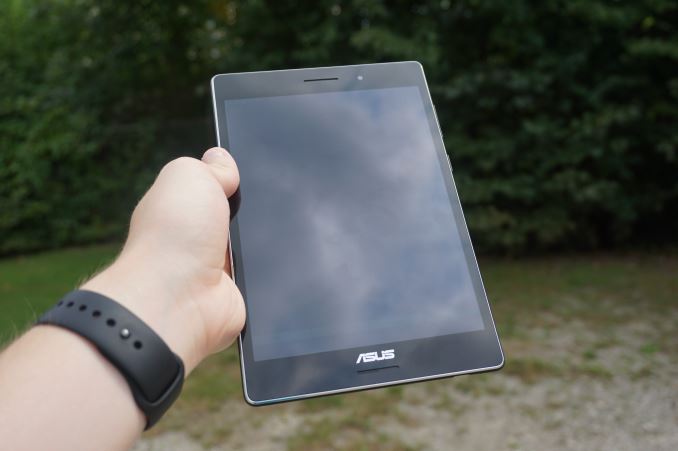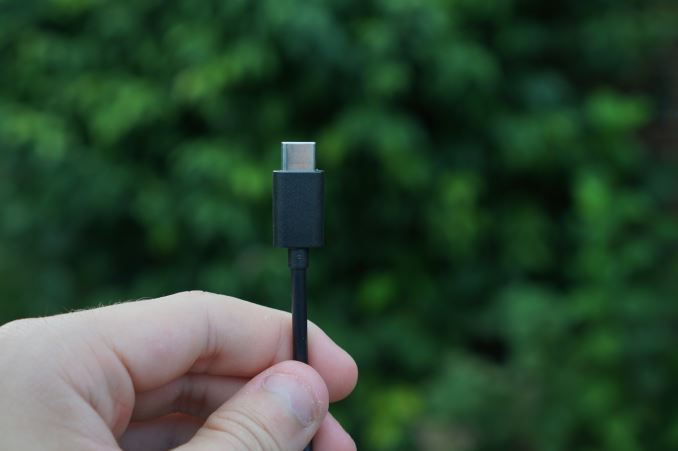The ASUS ZenPad S (Z580CA) Review
by Brandon Chester on August 31, 2015 8:00 AM EST
When I think of ASUS and Android, the first thing that comes to mind is their past portfolio of Android tablets. ASUS has been making Android tablets since the first wave of Android Honeycomb tablets hit the market. Back then, ASUS's point of differentiation from all the other Android tablets with essentially the same Tegra 2 hardware platform was their attachable keyboard dock. One could argue that ASUS really pioneered the 2-in-1 tablet form factor with their Transformer tablets.
While ASUS continued to release a number of additional Transformer tablets with updated specifications for some time, it has been a while since we've seen any new high end tablets from the company. Recent offerings have usually been more budget oriented devices like the MeMO Pad series, or the hard to find ASUS PadFone, with the spot for a more standard tablet being left unfilled.
Today's review takes a look at a tablet that doesn't pick up where the Transformer series left off, but instead kicks off a new line of tablets from ASUS under the ZenPad brand. There are a few different ZenPad tablets on the market, with multiple SKUs for each product creating even more versions. The tablet I'm looking at today is the ASUS ZenPad S, and more specifically, the ZenPad S Z580CA, which is ASUS's most high end tablet offering. Since the ZenPad S comes in two different versions I've laid out both of their specifications in the chart below so you can get an idea of how the two devices differ from each other.
| ASUS ZenPad S 8 (Z580C) | ASUS ZenPad S 8 (Z580CA) | |
| SoC | Intel Atom Moorefield Z3530 4x Silvermont @ 1.33GHz |
Intel Atom Moorefield Z3580 4x Silvermont @ 2.33GHz |
| GPU | PowerVR G6430 @ 457MHz | PowerVR G6430 @ 533MHz |
| RAM | 2GB LPDDR3 | 4GB LPDDR3 |
| NAND | 32GB + microSDXC | 64GB + microSDXC |
| Display | 7.85" 2048x1536 IPS LCD | |
| Dimensions | 203.2 x 134.5 x 6.6mm | |
| Mass | 298g | |
| Camera | 2MP Front-facing 5MP Rear-facing |
5MP Front-facing 8MP Rear-facing |
| Battery | 15.2Wh | |
| OS | Android 5.0 Lollipop with ASUS Zen UI | |
| Other Connectivity | 802.11b/g/n + BT 4.1, GNSS, 3.5mm audio | 802.11a/b/g/n/ac + BT 4.1, GNSS, 3.5mm audio |
| USB Connector | Micro USB | USB Type-C |
| Price | $199 USD | $299 USD |
There are two versions of the ZenPad S. The less expensive model is priced at $199 USD, while the more expensive model that I am reviewing is $299 USD. This is not unlike the price split between the two versions of the ZenFone 2. However, while the two versions of the ZenFone were differentiated only by their RAM, NAND, and included charger, the two models of the ZenPad S have more differences than similarities as far as their specifications go.
What's shared between both devices is the 7.85" 2048x1536 display. ASUS advertises it as 8.0" but measurements of the display's diagonal show that there is some rounding going on. In addition to the display, both devices have a 15.2Wh battery. At $100 more, the ZenPad Z580CA doubles your RAM and storage to 4GB and 64GB respectively, increases the resolution of both cameras, bumps the max CPU clock by 1GHz and max GPU clock by 76MHz, and adds 802.11ac support.
The one thing that sets the ZenPad S Z580CA apart from most other devices is its use of the new USB Type-C connector, along with support for USB 3.0 speeds of 5Gbps (Superspeed). While we have seen USB 3.0 featured on some past devices such as the Galaxy Note 3, the large size and unsightly appearance of the USB 3.0 Micro-B connector resulted in it receiving almost no market adoption. It's important to note that just because a device uses the USB Type-C connector does not mean that it supports USB 3.1 Gen 2 (Superspeed+) along with all the USB alternate modes for networking or display interfaces. With the ZenPad S Z580CA only supporting USB data, you cannot do video out or use any other USB alternate modes. Such features will have to wait for future SoCs and controllers with USB 3.1 and USB alt mode support.
As for the connector, Type-C is slightly larger than your standard Micro-B port in all dimensions, but it's reversible, more durable, and maintains a much stronger connection to a device. You can insert it in two orientations, and when you push it in there's a click to let you know that it connected. Some users will see the adoption of USB Type-C as a nuisance, as it will prevent them from using existing cables to charge the tablet or transfer files. I personally recognize this as an unavoidable transition period, as there's no chance of every vendor and user in the world deciding to move to Type-C all at once. It's obviously a bit of an annoyance to be unable to use existing Micro-B cables, but I believe the advantages are worth it.
The ZenPad S uses ASUS's ZenUI skin for Android. It's basically the exact same UI as on the ZenFone 2, but with some layout and app design changes to work better on the larger display. For a look at ZenUI I recommend looking at the software section of my ZenFone 2 review, as I won't be discussing it in this review due to it being mostly redundant.











114 Comments
View All Comments
DanNeely - Monday, August 31, 2015 - link
The "sharpening" filter that smudges text legibility is the deal breaker. Having tried using them before, I completely agree with the reviewer about how badly they suck. They might help in some circumstances; but having the opposite effect on one thing that needs legibility more than anything else makes them worse than useless as an always on feature.I still don't get what you're going on about the Samsung and $100 more. AGAIN, I don't find it too expensive compared to the Zenpad. If the Samsung didn't have retarded buttons it looks like it'd be a great device and I'd probably own one. Putting the same level of hardware in a chassis with buttons in the correct order shouldn't drive the price to $500.
MrSavage - Monday, August 31, 2015 - link
You think the Z580CA would have blurred or smudged text? I tell you this. I'm going into a store and seeing to believe. It's late 2015 and if you're telling me that a new tablet with new technology is going to have some blurry or unclear text or visuals? If this was 2012 I might buy that.Regarding Samsung and $100? Have you actually gone spec by spec to compare? Beyond that, if you put 2GB of RAM (Samsung with around 3) and the same 32GB of storage? I would bet this Z580CA would be selling for $250 or less! No front speakers, no stylus support on top of that. I think your idea of reasonable or wise differs from mine.
So you are taking a few charts on the display as being the final word? If there are any issues regarding software enhancements, I'm confident in firmware and software updates to resolve any possible issue. I have some faith in that and considering the price, it's not exactly a super risky proposition.
PixyMisa - Monday, August 31, 2015 - link
On specs, the $399 S2 is closer to the $199 Z580C. I expect the AMOLED screen will be very nice, though.A side-by-side comparison of the 8" iPad, S2, and Z580C/CA would be very interesting.
Kepe - Monday, August 31, 2015 - link
How about an HP Pro Slate 8? The only real downside seems to be the bundled pen contraption, but you don't have to use it, of course.DanNeely - Monday, August 31, 2015 - link
First I've seen it; but other than potential availability (HP doesn't have it in immediate stock, and Amazon appears to only have the Win8 model), I don't see any show stoppers in a quick look at reviews. Paying for a pen'd just end up in my junk drawer's annoying but if it's my only option...modulusshift - Monday, August 31, 2015 - link
Since I have an Air 2 running the latest iOS 9 beta, I decided to see what you meant by performance enhancements.Kraken 1.1 - 2446.3
Octane v2 - 10441
WebXPRT 2015 -
modulusshift - Monday, August 31, 2015 - link
162 was the WebXPRT score. So yeah, some improvements have definitely been made. The Air 2 now out scores every tablet score you have on that table by a significant margin.Brandon Chester - Monday, August 31, 2015 - link
Yeah that's what I meant. I will be able to update the iPad Air 2 once iOS 9 releases, but I don't have an Air or a Mini 2/3 on hand.modulusshift - Monday, August 31, 2015 - link
For fun, a MacBook Pro 13 on Yosemite:Kraken - 2013.6
Octane - 21636
WebXPRT 2015 - 320
Kepe - Monday, August 31, 2015 - link
In short: you get what you pay for. Display you have to calibrate yourself with software that makes it horrible, mediocre performance, mediocre build quality with low-quality materials, horrible camera, non-competitive battery life. But hey, at least you get front-facing stereo speakers that are ok!